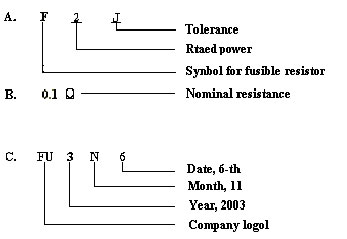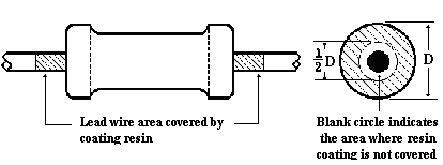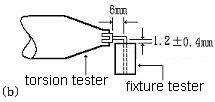| 1. Scope of the coverage: |
| This specification is pertinent to the application of fusible
film type resistors( designated as RF ). |
| 2 .Temperature range of the application: |
| -40℃ ~ +155℃。 |
| 3. Type: |
| Two types of fusible resistors are available, one is normal
size and the other one is small size. |
| These two types are distinguished by the color of the coating
resin. |
| The color of the resin for the normal size is gray and
that for the small size is pinkish red. |
| 4.Marking and illustration: |
| Two types of designation methods are available for fusible
resistors. |
| One is black ink alphanumeric marking and the other one
is color code marking. |
| The criteria of using either one of the marking methods
depend on the size of the resistors and |
| customers request which is listed in the following : |
| alphanumeric marking →1/2W、1W、2W、S1W 、S2W、S3W (Fig.1) |
| color code marking →1/6W、1/4W、1/3W、S1/4W、S1/2W (Fig.2) |
 |
| Illustration of color codes: |
 |
1-st Band
(Sig. digit) |
2-nd Band
(Sig. digit) |
3-rd Band
(Multiplier) |
4-th Band
(Tolerance) |
5-th Band
(Wattage) |
| Black |
0 |
0 |
1 |
. |
1/4W |
| Brown |
1 |
1 |
10 |
±1% |
. |
| Red |
2 |
2 |
100 |
±2% |
. |
| Orange |
3 |
3 |
1000 |
. |
. |
| Yellow |
4 |
4 |
10000 |
. |
. |
| Green |
5 |
5 |
100000 |
±0.5% |
. |
| Blue |
6 |
6 |
1000000 |
±0.25% |
. |
| Purple |
7 |
7 |
10000000 |
±0.1% |
. |
| Gray |
8 |
8 |
. |
±0.05% |
. |
| White |
9 |
9 |
. |
. |
1/6W、1/3W |
| Gold |
. |
. |
0.1 |
±5% |
. |
| Silver |
. |
. |
0.01 |
±10% |
S1/4W、S1/2W |
|
| |
| 5.Dimension, voltage, resistance range: listed
in the following Table |
|
Rated Power
(W) |
Resistance
Range (Ω) |
Highest working
(V) |
Highest Overload
(V) |
 2 2 |
| J ( ±5%) |
L |
Dψ |
ι |
dψ |
| 1/6、S1/4 |
0.1~1K |
100 |
150 |
3.5±0.5 |
1.7±0.3 |
27±3 |
0.45±0.05 |
| 1/4、1/3 |
0.1~15K |
250 |
300 |
6±0.3 |
2.4±0.1 |
28±2 |
0.6±0.05 |
| S 1/2 |
0.1~33K |
250 |
300 |
6±0.3 |
2.4±0.1 |
28±2 |
0.6±0.05 |
| S 1 |
0.1~33K |
250 |
300 |
9±0.5 |
3.0±0.5 |
30±3 |
0.8±0.05 |
| 1/2 |
0.1~4.7K |
250 |
300 |
9±0.5 |
3.0±0.5 |
30±3 |
0.6±0.05 |
| 1、S2 |
0.1~4.7K |
350 |
500 |
|
4.0±0.5 |
38±3 |
0.8±0.05 |
| 2、S3 |
0.1~4.7K |
350 |
500 |
|
5.5±0.5 |
38±3 |
0.8±0.05 |
|
| |
| 6.Coating |
 |
| 6.1 The body of the resistor is covered by nonflammable
silicon resin. |
| 6.2 The maximum length of the lead wire covered by the
resin is 2mm. |
| 6.3 The maximum area of the end cap which is not covered
by the resin is half of the diameter of |
| 6.3 the cap. |
| 6.4 The status of coating condition described by 6.2 and
6.3 are acceptable. |
| |
| 7.Characteristics of electrical performance : |
| 7.1 Rated power |
| The rated power indicates the maximum power the resistor
can endure continuously when the |
| ambient temperature is equal to or lower than 70℃. When
the ambient temperature is higher than |
| 70℃, the rated power of the resistor is determined by the
derating curve described in the following |
| figure. |
 |
| |
| 7.2 Rated voltage |
| The rated voltage of a resistor is either a continuous
DC voltage or an AC rms voltage which can be |
| calculated by the following formula. If the calculated
rated voltage is higher than the highest |
| working voltage then the highest working voltage should
be used as the rated voltage. |
 P: Rated power(W), R: Nominal resistance(Ω),
E: Rated voltage(V) P: Rated power(W), R: Nominal resistance(Ω),
E: Rated voltage(V) |
| |
| 7.3 Insulation resistance (Ref. JIS C5202 5.6) |
| Equipment : Insulation resistance tester |
| The body of the resistor is wrapped by the aluminum foil
without extending beyond the resistor |
| body. Clap one electrode on the aluminum foil and the other
electrode on the lead wire. Apply 100V |
| or 500V from the tester for 1 min. and the measured resistance
value should be larger than |
| 1,000MW. |
| |
| 7.4 Dielectric strength (Ref. JIS C5202 5.7) |
| Equipment: Dielectric strength tester |
| The body of the resistor is wrapped by the aluminum foil
without extending beyond the resistor |
| body. Clap one electrode on the aluminum foil and the other
electrode on the lead wire. Apply |
| following voltage from the tester to the resistor for 1
min.. No flash-over, burning or breakdown |
| should be observed. |
| Rated power (W) |
1/6、S1/4 |
1/4、1/3、S1/2、1/2、S1 |
1、2、S2、S3 |
| Voltage (V) |
200V |
250V |
300V |
|
| |
| 7.5 Short time overload (SOL) (Ref. JIS C5202 5.5) |
| Equipment: S.O.L. tester. |
| Apply 2 times of rated voltage to the resistors for 5 seconds.
After the test, the sample should be |
| stabilized at room temperature for 30 min. before the resistance
is measured. The change of the |
| resistance before and after the test should be: ±(2%+0.1Ω).
|
| |
| 7.6 Flame proof (Ref. to JIS C5202 7.12.3.4 (2)c) |
| Equipment: AC power supply |
| Apply 2 times, 4 times, 8 times, 16 times and
32 times of rated voltage sequentially. The duration |
| for each voltage application is 1 min.. The resistor
should not demonstrate arcing, burning or melt |
| down except the applied voltage exceeds 10 times
of rated power. Under this circumstance of |
| applied more than 10 times of rated power, arcing
or burning is acceptable but the duration should |
| be less than 5 sec. And the height of flame should
be less than 3.5mm. The maximum applied |
| voltage should not exceed 4 times of the value
listed in the following table: |
| Rated power (W) |
1/6、S1/4 |
1/4、1/3、S1/2、1/2、S1 |
1、2、S2、S3 |
| Highest voltage (V) |
200V |
250V |
300V |
|
| |
| 7.7 Fusing characteristics |
| 7.7 (residual resistance
after the test is more than 100 times of the original value) |
| Type |
Range |
|
|
|
|
Fusing Time |
| RFU1/6W、RFS1/4W |
0.10~1KΩ |
0.10~0.18Ω |
0.2~0.47Ω |
0.51~1KΩ |
------ |
≦60sec |
| RFU1/4W、RFU1/3W |
0.10~15KΩ |
0.10~0.22Ω |
------ |
0.24~9.1Ω |
1.0~15KΩ |
≦60sec |
| RFS1/2W |
0.10~33KΩ |
------ |
------ |
0.10~1.0Ω |
1.1~33KΩ |
≦60sec |
| RFS1W |
0.10~33KΩ |
------ |
------ |
0.10~1.0Ω |
1.1~33KΩ |
≦60sec |
| RFU1/2W |
0.10~4.7KΩ |
0.10~0.33Ω |
0.47~0.91Ω |
1.0~9.1Ω |
1.0~4.7KΩ |
≦60sec |
| RFU1W、RFS2W |
0.10~4.7KΩ |
------ |
------ |
0.10~1.0Ω |
1.1~4.7KΩ |
≦60sec |
| RFU2W、RFS3W |
0.10~4.7KΩ |
------ |
------ |
0.10~1.0Ω |
1.1~4.7KΩ |
≦60sec |
|
| |
| 8.Environmental tests |
| 8.1 Load life test (Endurance with rated load) (Ref. To
JIS C5202 7.10) |
| Equipment: High temperature chamber and DC power supply |
| The resistors are put in a fixture where no interference
will be allowed. Put the fixture in a 70±3℃ |
chamber and apply rated voltage with a cycle of 90 min.
ON and 30 min. OFF for  hours.
hours. |
| After 240, 480, 720 and 1,000 hours, the resistors are
taken out and stabilize at room temperature |
| for 30 min. and then the resistance is measured. Upon each
step of measurement, the change of |
| the resistance should not exceed ±(5%+0.1Ω) and the appearance
should show no remarkable |
| abnormality and legibility of marking. |
| |
| 8.2 Resistance to damp heat (Ref. To JIS C5202 7.2) |
| Equipment: Constant temperature and humidity chamber |
| The resistors are put in a 40±2℃ chamber with RH=90~95%
for 240±4 hours. After the test, take |
| the resistors out and stabilize in room temperature for
1 - 4 hour. Measure the resistane. The |
| acceptable change of resistance should not exceed ±(2%+0.1Ω)
and the appearance should show |
| no remarkable abnormality and legibility of marking. |
| |
| 8.3 Endurance under damp heat and load ()Ref. To JIS C5202
7.9) |
| Equipment: Constant temperature and humidity chamber, DC
power supply |
| The resistors are put in a fixture where no interference
will be allowed. Put the fixture in a 40±2℃ |
| chamber with RH=90~95% and apply rated voltage with a cycle
of 90 min. ON and 30 min. OFF for |
 hours. Water drops should avoid dripping
on the resistors. After 240 and 1,000 hours, the hours. Water drops should avoid dripping
on the resistors. After 240 and 1,000 hours, the |
| resistors are taken out and stabilize at room temperature
for 1 hour and then the resistance is |
| measured. Upon each step of measurement, the change of
the resistance should not exceed |
| ±(5%+0.1Ω) and the appearance should show no remarkable
abnormality and legibility of marking. |
| |
| 8.4 Temperature coefficient (TCR) (Ref. To JIS C5202 5.2) |
| Equipment: High temperature chamber |
| Measure the resistance at room temperature. Put the resistor
in a chamber with the temperature |
| of RT+100℃ for 30 - 45 min. to become stabilized. Measure
the resistance again. Compare the |
| resistance at these two temperatures with the following
equation and the acceptable value is ±350 |
| PPM/℃. |
 |
| R = Resistance at T T = RT + 100℃ Ro = Resistance at To
To =room temperature |
| |
| 8.5 Temperature cycling (Ref. To JIS C5202 7.4) |
| Equipment: High temperature chamber, low temperature chamber |
| Measure the resistance before the test. Put the resistors
to -55℃ chamber for 30 min. then take it |
| out at room temperature for 2 to 3 min.. Put the resistor
to +155 ℃chamber for 30 min. then take it |
| out at room temperature for 2 to 3 min. This complete a
cycle. Repeat the cycle 5 times. Put |
| resistors at room temperature for 90 min. and then measure
the resistance. Compare the |
| resistance before and after test. The acceptable change
of resistance is ±(1%+0.1Ω). The |
| appearance should show no remarkable abnormality and legibility
of marking. |
| |
| 9.Mechanical performance |
| 9.1 Resistance to soldering heat (Ref. To JIS C5202 6.4) |
| Equipment: Solder bath |
| Measure the resistance before the test. Immerse part of
the lead wire which is 4±0.8mm away from |
| the body to the flux for 5 - 10 sec. Take the resistor
out and immerse resistors in the solder bath of |
| 350±10℃ for 3.5±0.5 sec.. Stabilize at room temperature
for 1 hour and then measure the |
| resistance value. Compare the resistance values before
and after the test, The acceptable change |
| is ±(1%+0.1Ω). |
| |
| 9.2 Solderability (Ref. To JIS C5202 6.5) |
| Equipment: Solder bath |
| Immerse part of the lead wire which is 4±0.8mm away from
the body to the flux for 5 - 10 sec. Take |
| the resistor out and immerse resistors in the
solder bath of 245±5℃ for 3.5±0.5 sec.. Take the |
| resistor out and inspect the lead wire visually.
The acceptable level is the coverage of the new |
| solder to be 95%. The composition of the solder bath is
99.7% tin and 0.3% Cu. |
| |
| 9.3 Robustness of terminals (Ref. To JIS C5202 6.2)→should
be able to with hold 5Kg |
| 9.3.1 Tensile strength of termination |
| Equipment: Weight gauge |
| Fixed the resistor and apply axially along the lead wire
of 2.5Kg (0.8φ lead wire) or 1.0Kg (0.6φ lead |
| wire) for 30 sec.. The lead wire should not break or detached
from the resistor and the change of |
| the resistance should be less than ±(0.5%+0.1Ω). For the
destructive test, the lead wire of |
| 0.6φshoul dbe able to withhold 5Kg, that of 0.8φshopuld
be bale to withhold 10Kg. |
| |
| 9.3.2 Torsional strength |
| Equipment: Torsion tester |
| Bend the terminal 6.4mm away from the body according to
Fig-a to 90 degree with a curvature of |
| 0.75mm~0.80mm. The lead wire should be clamped at a point
of 1.2mm away from the bending |
| point by a fixture which can rotate 360 degree according
to Fig-b. Rotate the resistor 360 degree |
| clockwise and counter clockwise for 1 cycle. The rotation
speed is 360 degree per 5 sec. Perform |
| 0.45φ lead wire 1 cycle and 0.52φ, 0.60φ 1.5 cycles. The
terminal should not |
| break down or detached from the body. The acceptable change
of resistance is ±(0.5%+0.1Ω). |
| |
  |
| |



